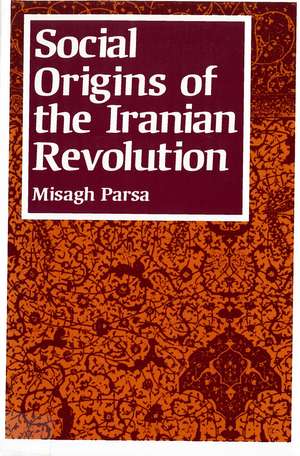Social Origins of the Iranian Revolution
Autor Misagh Parsaen Limba Engleză Paperback – sep 1989
Misagh Parsa develops a structural theory of the causes and outcomes of revolution, applying the theory in particular to Iran. He focuses on the ends and means of various groups of Iranians before, during, and after the revolution. For Parsa, revolution is not a direct result of ideologies, which may be less important than structural factors such as the nature of the state and the economy, as well as each group's interests, capacity for mobilization, autonomy, and solidarity structures.
Existing theories of revolution explain earlier revolutions better than the Iranian revolution. In Iran most of the protest was in urban areas, the peasants never played a major role, and power was transferred to the clergy, not to an intelligentsia. In the 1970s, oil revenues increased, the economy developed rapidly but unevenly, and the state's expanded intervention undermined market forces and politicized capital accumulation. Systematic repression of workers, aid to the upper class, and attacks on secular and religious opposition showed that the state was serving the interests of particular groups. When the state tried to check high inflation by imposing price controls on bazaaris (merchants, shopkeepers, artisans), their protests forced the state to introduce reforms, providing an opportunity for industrial workers, white-collar workers, intellectuals, and the clergy to mobilize against the state. Thus, structural features rendered the state vulnerable to challenge and attack.
Parsa's thorough explanation of the collective actions of each major group in Iran in the three decades prior to the revolution shows how a coalition of classes and groups, using mosques as safe gathering places and led by a segment of the clergy, brought down the monarch of 1979. In the years since the revolution, the conflicts that existed before the revolution seem to be reemerging, in slightly altered form. The clergy now has control, and the state has become centrally and powerfully involved in the economy of the country.
Existing theories of revolution explain earlier revolutions better than the Iranian revolution. In Iran most of the protest was in urban areas, the peasants never played a major role, and power was transferred to the clergy, not to an intelligentsia. In the 1970s, oil revenues increased, the economy developed rapidly but unevenly, and the state's expanded intervention undermined market forces and politicized capital accumulation. Systematic repression of workers, aid to the upper class, and attacks on secular and religious opposition showed that the state was serving the interests of particular groups. When the state tried to check high inflation by imposing price controls on bazaaris (merchants, shopkeepers, artisans), their protests forced the state to introduce reforms, providing an opportunity for industrial workers, white-collar workers, intellectuals, and the clergy to mobilize against the state. Thus, structural features rendered the state vulnerable to challenge and attack.
Parsa's thorough explanation of the collective actions of each major group in Iran in the three decades prior to the revolution shows how a coalition of classes and groups, using mosques as safe gathering places and led by a segment of the clergy, brought down the monarch of 1979. In the years since the revolution, the conflicts that existed before the revolution seem to be reemerging, in slightly altered form. The clergy now has control, and the state has become centrally and powerfully involved in the economy of the country.
Preț: 296.49 lei
Nou
Puncte Express: 445
Preț estimativ în valută:
56.74€ • 60.67$ • 47.30£
56.74€ • 60.67$ • 47.30£
Carte tipărită la comandă
Livrare economică 17 aprilie-01 mai
Preluare comenzi: 021 569.72.76
Specificații
ISBN-13: 9780813514123
ISBN-10: 0813514126
Pagini: 368
Dimensiuni: 152 x 229 x 25 mm
Greutate: 0.55 kg
Ediția:None
Editura: Rutgers University Press
Colecția Rutgers University Press
ISBN-10: 0813514126
Pagini: 368
Dimensiuni: 152 x 229 x 25 mm
Greutate: 0.55 kg
Ediția:None
Editura: Rutgers University Press
Colecția Rutgers University Press
Notă biografică
Misagh Parsa has taught in the sociology department at the University of Michigan and currently teaches at Dartmouth College.
Cuprins
List of Figures and Tables
Preface
PART 1: INTRODUCTION AND BACKGROUND
1 Explanations of the Revolution
2 The Politics of Power
3 State Accumulation Policies
PART 2: MOBILIZATION AND REVOLUTION
4 The Bazaar
5 Autumn Allies
6 The Secular Contenders
7 The Mosque and Islamic Forces
PART 3: DENOUEMENT
8 The Final Collapse
9 Conflicts within the Islamic Republic
10 Conclusion
Notes
References
Index
Preface
PART 1: INTRODUCTION AND BACKGROUND
1 Explanations of the Revolution
2 The Politics of Power
3 State Accumulation Policies
PART 2: MOBILIZATION AND REVOLUTION
4 The Bazaar
5 Autumn Allies
6 The Secular Contenders
7 The Mosque and Islamic Forces
PART 3: DENOUEMENT
8 The Final Collapse
9 Conflicts within the Islamic Republic
10 Conclusion
Notes
References
Index
Recenzii
An excellent analysis of the Iranian revolution... of interest not only to Middle East specialists but also to general scholars of revolution.
Descriere
Parsa's thorough explanation of the collective actions of each major group in Iran in the three decades prior to the revolution shows how a coalition of classes and groups, using mosques as safe gathering places and led by a segment of the clergy, brought down the monarch of 1979. In the years since the revolution, the conflicts that existed before the revolution seem to be reemerging, in slightly altered form. The clergy now has control, and the state has become centrally and powerfully involved in the economy of the country.
